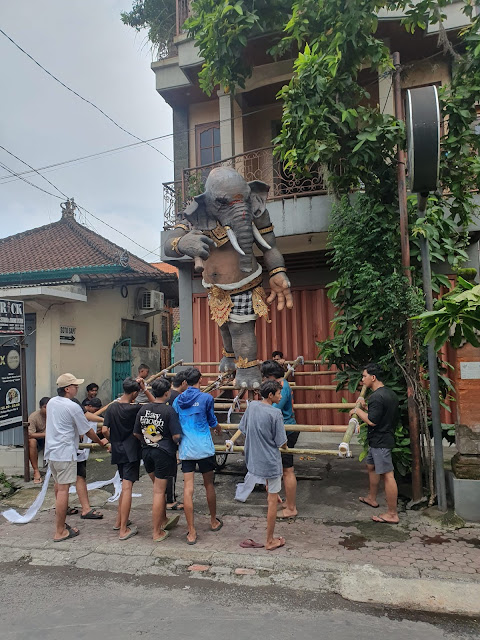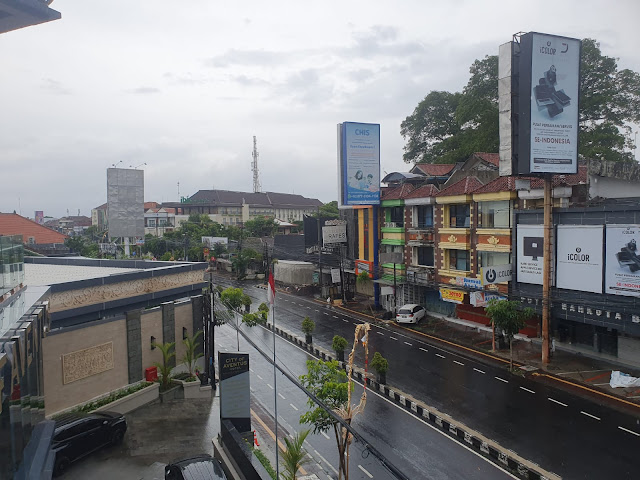Flying from Jogja (see part 1 of this trip report) to Bali was a chance to check out domestic tourism culture.
For one thing, everyone is laden with cartons of bakpia, the primary "oleh-oleh", or local souvenir, of Jogja. This oleh-oleh thing was mystifying at first, not least because bakpia doesn't even taste very good (like Malaysian tau sar pia, but less interesting).
But it's not really about the taste (though I think many Indonesians don't mind any sort of snack). A Geek in Indonesia tells me that local tourists are obliged to buy cartloads of oleh-oleh for distribution back home. It's like what Singaporeans used to do with Tokyo Banana from Japan, or egg rolls from Hong Kong, before travel became so commonplace as to render these gifts worthless.
Every Indonesian tourist place has its own oleh-oleh. Oleh-oleh must either have the place-name prominently displayed on the item (think tie-dye tees or phallus keychains emblazoned with BALI) or be decorated ostentatiously (Bali's bakpia, Pie Susu, comes in boxes with Balinese dancers all over them). Finally, the oleh-oleh emporium is an important part of your trip intinerary.
In Bali we found two such stores, Krisna and Erlingga 2, within walking distance of our Denpasar city hotel. And they are so. much. fun!! Imagine if Mustafa shopping centre was housed in a royal palace. Massive amounts of merchandise laid out neat as a pin. Massive car park (for coaches of course), air conditioning, clean toilets and most importantly, price tags on everything.
I was skeptical at first, but once we started trying out "resort wear", we went nuts. Each garment was only a few bucks and surprisingly well-made and comfy. It was like a real-life SHEIN, only ethnic looking, and yay no polyester was harmed in the making. I bought sandals, Jon bought knick-knacks, I bought pie susu, Jon bought keropok. We enjoyed the complete and surprising absence of sales people. It was awesome.
Here we are flaunting our batik garb.


Okay, but oleh-oleh was only a pleasant diversion. The main point of our trip was to experience Nyepi, aka Silent Day. On Nyepi the entire island goes dark and silent for 24 hours, the airport shuts down, no one leaves home, and pecalang (local police) roam the streets with flashlights to catch errant tourists.
Nyepi ate up all 3 days of our trip really. The day before Nyepi is like CNY Eve - businesses shut down early or don't run at all, and traffic is intense as almost all Balinese people head back to their villages in time for Nyepi eve celebrations. I had agonised over whether to visit Tanah Lot temple on this day, but turns out the choice was made for me - no drivers were online on Gojek or Grab.
We just walked around and looked at Balinese kids getting ready for the ogoh-ogoh parade that night.
We settled ourselves at the roundabout 500 metres away from our hotel along with probably thousands of locals. After hours of not much action, and getting rained on, the ogoh-ogoh finally made their rounds on the streets, and the crowds went nuts. All this was happening without road closures, and you have to hand it to the pecalang for doing both crowd and traffic control in the chaos.
Then it was Nyepi, the day of silence...
You're supposed to fast and meditate for Nyepi. But I opted for a hotel with a package, i.e. with all 3 meals and entertainment (pool, gym, movies) included. So in the end we didn't get the Nyepi experience. We spent the day eating, napping, eating again, reading, doing the crossword, and eating again. It's disturbing how much of one's activities revolve around food and entertainment.
After dark we went up to the rooftop to look at the city. Bali was in total darkness and silence. (On Nyepi you're allowed only a dim light, and our windows were taped up to not let the light seep through.)
The day after Nyepi (most shops still closed) we made our way to see Omed-Omedan, a riotous street festival in Denpasar. The street was closed to traffic and lined with food stalls; this was where I had my longed-for meal of nasi babi guling. The pork was fresh, the little bowl of broth complex, but the highlight was the greens - I think they're daun singkong, or cassava leaves. Delicious.
After filling our tummies and washing the babi guling down with "es cappucino cincau" (quite nice, actually) we went to watch the celebrations. Well I say "watched" but we all had to take part, because the pecalang, armed with water hoses and buckets, gleefully sprayed the audience members. During the "pulling" ceremony, Balinese boys and girls rushed one another as the crowd roared and pecelang dumped more water on their heads. It was a crazy soggy mess but so much fun. Now I want to go for Songkran.
I liked that we stayed in Denpasar. Not many tourists stay there so it felt more real, less fake-pretty like a beachside or Ubud-type locale. You get a sense of the people working behind the scenes to make Bali an exotic fantasy. Not just the Balinese, but also the (probably scads of) migrant workers working as cleaners and hotel staff and powering the Gojek/Grab army. (Our Gojek driver came all the way from Papua!)

.jpeg)



.jpeg)



.jpeg)
.jpeg)

.jpeg)

.jpeg)


Comments
Post a Comment